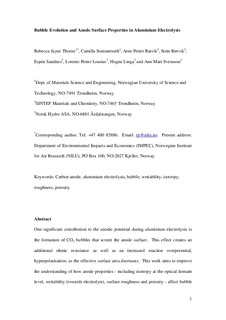| dc.contributor.author | Thorne, Rebecca Jayne | |
| dc.contributor.author | Sommerseth, Camilla | |
| dc.contributor.author | Ratvik, Arne Petter | |
| dc.contributor.author | Rørvik, Stein | |
| dc.contributor.author | Sandnes, Espen | |
| dc.contributor.author | Lossius, Lorentz Petter | |
| dc.contributor.author | Linga, Hogne | |
| dc.contributor.author | Svensson, Ann Mari | |
| dc.date.accessioned | 2017-11-02T14:11:03Z | |
| dc.date.available | 2017-11-02T14:11:03Z | |
| dc.date.created | 2015-08-18T12:36:49Z | |
| dc.date.issued | 2015 | |
| dc.identifier.citation | Journal of the Electrochemical Society. 2015, 162 (8), E104-E114. | nb_NO |
| dc.identifier.issn | 0013-4651 | |
| dc.identifier.uri | http://hdl.handle.net/11250/2463770 | |
| dc.description.abstract | One significant contribution to the anodic potential during aluminum electrolysis is the formation of CO2 bubbles that screen the anode surface. This effect creates an additional ohmic resistance as well as an increased reaction overpotential, hyperpolarization, as the effective surface area decreases. This work aims to improve the understanding of how anode properties - including isotropy at the optical domain level, wettability (toward electrolyte), surface roughness and porosity - affect bubble evolution. Pilot anodes, made with single source coke types varying in isotropy, were used to study bubble evolution by electrochemical methods. In order to retain bubbles during experiments, anodes were designed to have only horizontal surface area. Bubble formation and release were monitored at different current densities, and were tracked by measuring the oscillations in anode potential and series resistance. Anodes made from different cokes were found to have different bubble evolution properties, possibly due to variation in the density of nucleation sites at the surface of each anode and varying anode-electrolyte wettability. | nb_NO |
| dc.language.iso | eng | nb_NO |
| dc.publisher | Electrochemical Society | nb_NO |
| dc.title | Bubble evolution and anode surface properties in aluminium electrolysis | nb_NO |
| dc.type | Journal article | nb_NO |
| dc.description.version | submittedVersion | nb_NO |
| dc.source.pagenumber | E104-E114 | nb_NO |
| dc.source.volume | 162 | nb_NO |
| dc.source.journal | Journal of the Electrochemical Society | nb_NO |
| dc.source.issue | 8 | nb_NO |
| dc.identifier.doi | 10.1149/2.0321508jes | |
| dc.identifier.cristin | 1258581 | |
| dc.description.localcode | This is a submitted manuscript of an article published by Electrochemical Society in Journal of The Electrochemical Society, May 12, 2015 | nb_NO |
| cristin.unitcode | 194,66,35,0 | |
| cristin.unitname | Institutt for materialteknologi | |
| cristin.ispublished | true | |
| cristin.fulltext | preprint | |
| cristin.qualitycode | 2 | |
